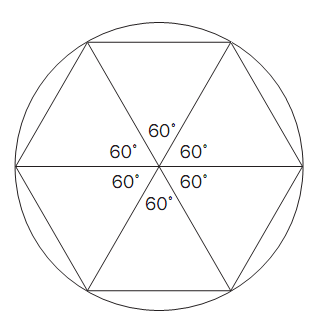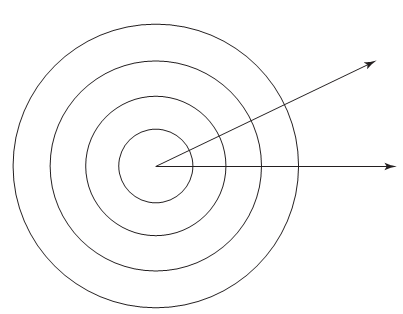The problem of measuring angles has been considered by mathematicians since ancient times. The ability to measure angles with some precision is important in fields such as astronomy, physics, engineering, and architecture, as well as in various practical supporting fields such as carpentry. It is difficult to imagine the ancient Egyptians trying to construct the pyramids without a precise system for measuring angles, particularly right angles.
The problem of measuring angles is compounded by the need for a satisfactory definition of the object to be measured. It was not until the concept of a set was developed in the late nineteenth century that the modern definitions of geometric objects such as sets of points were possible, and it was well into the twentieth century before such definitions began to appear in geometry textbooks. As late as the 1920s an angle was typically defined by one of three methods:
1. The difference in inclination (slant) to each other of two lines that intersect (meet or cross);
2. The amount of turning (rotation) necessary to bring one side to the position of the other; or
3. The portion of the plane included between its sides.
By the 1940s, there was some movement toward the modern approach in definitions such as “the geometric figure formed by two rays drawn from the same point,” but it was not until the 1960s that the modern definition of an angle as “the union of two rays having a common endpoint” was commonly used in textbooks.
While the modern definition rightly focuses attention on the points forming the object itself, the older definitions seem to hint more at the measurement of that object. In particular, the first two definitions above suggest a rotational aspect of angle measurement. On the other hand, the third definition suggests a more static (without rotation) aspect of angle measurement. There are numerous applications of both aspects. For example, civil engineers measuring the grade (inclination) of a newly cut road pan are interested in the amount to turn the transit above or below a horizontal line, but an opthamologist measuring a patient’s field of vision is interested in the portion of a plane the patient can see without moving her or his eyes.
Early Measurements of Angles
Ancient civilizations were first concerned with measuring right angles, because of the importance of right angles in the construction of buildings and in surveying. Early instruments for measuring right angles included tools resembling the modern carpenter’s square, the baculum (sometimes called the geometric cross or cross-staff), and a rope stretched to form a 3-4-5 right triangle.
The baculum consisted of a flat rod approximately 4 feet in length with a cross-piece that could be slid along the rod while remaining always perpendicular to it. The idea of stretching a rope into the form of a known figure, such as the 3-4-5 right triangle was immortalized by the Egyptian “rope-stretchers.”
The concept of measuring angles other than right angles requires some consistent unit of measure. Sometimes that unit angle appears to have been the right angle, as in the ancient Greek’s use of the right angle in stating relationships among angles. For example, in the Elements, Euclid wrote that the three interior angles of a triangle are equal to two right angles. However, the ancient Babylonians chose a different unit angle which led to the development of the degree, the unit of angle measure which we know today.
The Angle-Circle Connection.
Most historians think that the ancient Babylonians believed that the “circle” of the year consisted of 360 days. This is not a bad approximation given the crudeness of the ancient astronomical tools. Historians of mathematics also generally believe that the ancient Babylonians knew that the side of a regular hexagon inscribed in a circle is equal in length to the radius of the circle. This may have suggested to them a division of the full circle (360 “days”) into six equal parts, each part consisting of 60 “days” as shown below. Once they divided the angle of an equilateral triangle into the 60 equal parts now called degrees, they further subdivided a degree into 60 equal parts, called minutes, and a minute into 60 equal parts called seconds.

Many scholars believe this explains the use of 60 as the base of the Babylonian system of angle measurement. However, others believe that the use of 60 as the base had more to do with the fact that 60 has many integral divisors. Work with fractional parts of the whole (60) is greatly simplified, because 2, 3, 4, 5, 6, 10, 12, 15, 20, and 30 are all divisors of 60.
Regardless of which account is accurate, the Babylonians’ use of the degree as a unit of angle measure has survived to the present era, and one degree represents 1/360 of a circle. The genius of basing the measurement of angles on the circle is that it does not matter which circle is used: the angle cuts off the same fractional part of the circle, as shown below.

It is also noteworthy that the Babylonian choice of 360 for the number of equal subdivisions of a circle was arbitrary. They might have subdivided the circle into any number of equal parts. In fact, the gradient—a seldomused unit of angle measurement that can infrequently be encountered in engineering—is based on subdividing a right angle into 100 equal parts. Then, since a circle consists of four right angles, there are 400 gradients in a circle.
Making Indirect Measurements
Once the ancients had developed the capacity to measure angles with precision, they had one of the tools necessary for indirect measurement. Indirect measurement simply refers to methods for obtaining measurements of properties of figures, particularly distances, which are inaccessible to direct measurement. The work of engineers, surveyors, cartographers, and astronomers would be rendered virtually impossible without indirect measurement schemes. In fact, the branch of mathematics known as trigonometry arose as a response by ancient Greek mathematician-astronomers to the problem of obtaining inaccessible measurements: the distances and angles between certain celestial bodies.
In the period from about 250 B.C.E. to 200 C.E., Greek mathematicians undertook the first systematic study of relationships between ratios of distances and angle measures and between the lengths of chords of a circle and the measures of the angles in the circle, or arcs of the circle, which subtended (or cut off) those chords. As a result of this work, all that was needed to supply reasonable estimates of otherwise inaccessible celestial measurements was a fairly precise measure of the radius of Earth.
The ancient Greek mathematician Eratosthenes of Cyrene had provided the means for such estimates by determining the circumference of Earth with astonishing accuracy in about 250 B.C.E. To do so, Eratosthenes had to use a form of indirect measurement. He observed that at high noon on the day of the summer solstice, the Sun shone directly down a deep well in the city of Syene in Egypt. He had also observed that at the same time (high noon on the day of the summer solstice) in the city of Alexandria, 500 miles due north of Syene, the Sun cast shadows showing that the angular distance between Syene and Alexandria was 1/50th of a circle. Therefore, Eratosthenes reasoned that the circumference of Earth should be 50 times the distance from Syene to Alexandria, or about 25,000 miles. The remarkable accuracy of this estimate is one of the crowning achievements of ancient astronomy.
______________________________________________________________________________________________
Reference
Ball, W. W. Rouse. A Short Account of the History of Mathematics. New York: Dover, 1960.
Boyer, Carl B., revised by Uta C. Merzbach. A History of Mathematics, 2nd ed. New York: John Wiley & Sons, 1991.
Coxford, Arthur, Zalman Usiskin, and Daniel Hirschhorn. Geometry. Glenview, IL:Scott Foresman, 1991.
Wilson, Patricia S. and Verna M. Adams. “A Dynamic Way to Teach Angle and Angle Measure.” Arithmetic Teacher, 39, 5 (1992): 6–13.
 الاكثر قراءة في الرياضيات العامة
الاكثر قراءة في الرياضيات العامة
 اخر الاخبار
اخر الاخبار
اخبار العتبة العباسية المقدسة


